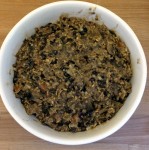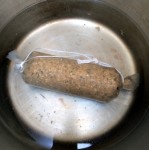Recipe for Vegetarian Haggis
Traditional haggis is made from sheep’s offal, encased in a sheep’s stomach. This recipe aims to provide something of the texture and robust flavours of traditional haggis but in a meat-free form. Artificial casings are available (made from cellulose, usually), but steaming the haggis in a pudding basin is both easy and effective.
Traditional accompaniments for haggis are bashed neeps and tatties (mashed swede and potatoes).
Ingredients (for 6)
 60 g dried green lentils
60 g dried green lentils- 60 g pearl barley
- 250 g portobello (flat) mushrooms
- 180 g ready-to-eat peeled chestnuts (frequently vacuum-packed)
- 1 medium carrot, peeled and finely chopped
- 1 large onion, peeled and finely chopped
- 150 g pinhead oatmeal
- 75 g vegetable suet
- 1 tsp marmite (yeast extract)
- 1½ tsp black treacle
- 1½ tsp salt
- 1 tsp white pepper
- 1 tsp mixed spice
- Casings, if required (see notes)
Method
- Boil the lentils & pearl barley in unseasoned water for 30 minutes or until tender but not soft. Drain them and put them into a large mixing bowl.
- Chop the mushrooms into dice and gently fry them with the carrot and onion for about 20 minutes in a little oil or butter. When cooked, add them to the mixing bowl.
- Coarsely chop the chestnuts and add them, with the oatmeal and suet to the mixing bowl. Add the salt, pepper and mixed spice. Mix everything thoroughly.
- Dissolve the marmite (yeast extract) and black treacle in 300 ml of hot water from a recently boiled kettle and pour over the mixture. Mix thoroughly again.
 If you are using artificial casings, they may need soaking before use. Fill the casings and tie them off securely with string. Put them into a large saucepan and cover them with cold water. Bring them to a boil and simmer, gently, for two hours. Check, from time to time, whether the water needs topping up. I prefer to steam my haggis in pudding basins: the no-hassle approach.
If you are using artificial casings, they may need soaking before use. Fill the casings and tie them off securely with string. Put them into a large saucepan and cover them with cold water. Bring them to a boil and simmer, gently, for two hours. Check, from time to time, whether the water needs topping up. I prefer to steam my haggis in pudding basins: the no-hassle approach.
Notes
- The marmite and treacle combined provide the umami flavours and a slight sweetness typical of the traditional formula’s offal meats.
- Artificial casings usually require soaking before use. Follow the supplier’s instructions, but my experience has been that they are inflexible and won’t stretch much. Don’t overfill the casings, or they may burst as the contents expand in cooking, spoiling them.
- Some proportions to help you vary the quantity if you wish: weigh the cooked vegetables/pulses and add 10% by weight of suet, 20% by weight of oatmeal and 40% by weight in water. The quantities given above assume that you have 750 g of cooked vegetables/pulses.
This is the second in a short series of Scottish recipes. The others include traditional Haggis and All-Butter Shortbread.


So that’s this year’s haggis just gone into the steamer for our Burns Supper, later. I marginally prefer this vegetarian recipe over the more traditional offal-based alternative, and while I only make haggis once a year (but in a batch that feeds us more than once), I tend to alternate recipes from one year to the next – they’re both good.
LikeLike